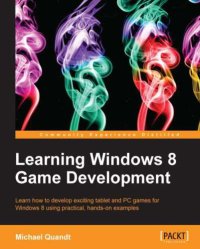
Ebook: Learning Windows 8 Game Development
Author: Quandt Michael
- Tags: Computer games--Programming, Electronic books, Microsoft Windows (Computer file), Computer games -- Programming
- Series: EBL-Schweitzer
- Year: 2013
- Publisher: Packt Publishing
- City: Birmingham
- Edition: Online-ausg
- Language: English
- epub
LoadingCo-ordinate systems; Drawing the sprites; Sorting modes; Finishing the batch; Vectors; Text rendering; TTF versus BMP; Building the font; Drawing the font; Summary; Chapter 3: Adding the Input; Input devices; Pointers; Keyboard input; GamePad input; Multiple controllers; Buttons; Deadzones and thumbsticks; Summary; Chapter 4: Adding the Play in the Gameplay; Structuring a game; Traditional object-oriented design; Components and entities; Putting it all together; Subsystems; Refining the input system; Trigger; Action; InputManager; Triggers; Renderer; Resource management; Culling.
ImplementationCollision detection; Rectangle collision; Fighting for score; Summary; Chapter 5: Tilting the World; Orientation; Accelerometer; Shaking things up a bit; Spinning with gyros; Compass; Inclinometer; Orientation for games; Practice makes perfect; Other sensors; Light; Locking on with a GPS; Status; Position; Polling; Summary; Chapter 6: Bragging Rights; Game state and progression; Sharing in Windows 8; WinRT components; Live tiles; Summary; Chapter 7: Playing Games with Friends; A better menu system; Networking; Choosing between client/server and peer-to-peer models.
The client/server modelThe peer-to-peer model; Maybe a hybrid?; The first stage; Using the PeerFinder; Communicating the gameplay; TCP - StreamSocket; UDP - DatagramSocket; Reading and writing data; Summary; Chapter 8: Getting into the Store; Getting into the store; Free accounts; Submitting your game; GDF Certificates; App packages; Capabilities; Adding a privacy policy; Declarations; Certification kit; Creating your app packages; Uploading and submitting; Certification tips; Privacy; Features; Legacy APIs; Debug; WACK; Summary; Chapter 9: Monetization; Selling your games.
Monetization modelsThe freemium model; The traditional model; The hybrid model; The trial mode; In-app purchases; The consumables; Testing with the simulator; Summary; Appendix: Adding the Third Dimension; Vertices and triangles; Indices; Cameras; DirectXMath; Buffers; Building the vertex and index buffers; Setting the buffers; Using the buffers; Constant buffers; Updating the buffers; Mapping the buffer; The UpdateSubresource() method; Shaders; Vertex shaders; Pixel shaders; Compiling and loading; Input layouts; Drawing the model; Setting the buffers and drawing; Summary; Index.
A standard practical tutorial running people through Windows 8 RT with a specific focus on game development is the approach chosen here. This type of approach will more likely appeal to an audience that is in need of a structured guide that they can emulate and learn from, unlike the usual reference text available in the market. Learning Windows 8 Game Development is for any developer looking to branch out and make some games. It's assumed that you will have an understanding of C++ and programming. If you want to program a game, this book is for you, as it will provide a great overview of Direc.